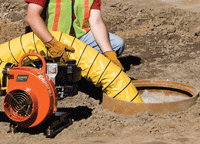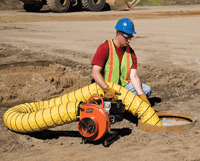
A Breath of Fresh Air
Using air ventilation blowers is the best way to maintain acceptable oxygen levels in a workspace.
- By Dennis Von Ruden
- Aug 01, 2009
 Pause for a moment to take a few deep breaths. Inhale, exhale, and repeat. For something we do continuously, it's strange how seldom we actually think about breathing. In fact, beyond activities such as meditation and exercise, we're rarely conscious of breathing, simply because it's an automatic process. Still, it is something we do, on average, more than 20,000 times per day, every day. And with each breath, oxygen and a mixture of other gases enter our bodies. But if the air is contaminated, harmful toxins may be entering our systems, as well.
Pause for a moment to take a few deep breaths. Inhale, exhale, and repeat. For something we do continuously, it's strange how seldom we actually think about breathing. In fact, beyond activities such as meditation and exercise, we're rarely conscious of breathing, simply because it's an automatic process. Still, it is something we do, on average, more than 20,000 times per day, every day. And with each breath, oxygen and a mixture of other gases enter our bodies. But if the air is contaminated, harmful toxins may be entering our systems, as well.
When it comes to our health, all of us have the desire and the need to breathe clean air. In fact, research shows that cities with better air quality generally have healthier residents. When thinking of air quality, one would immediately think of outdoor pollutants, such as vehicle and factory emissions, right? However, outdoor hazards are not the only concern related to air quality. Indoor air quality is just as important. And for individuals working in confined spaces, high-quality, breathable air is a necessity.
Improper ventilation in confined spaces leads to unfortunate worker deaths every year. What is especially upsetting is that if more people followed proper procedures and abided by government-established regulations concerning confined spaces, the number could be greatly reduced. Because ignorance often leads to these tragic deaths, let's take a look at some information about confined spaces and how to properly ventilate them to avoid accidents. This will give you a good idea of what needs to be known in order for an employer to provide a safe environment for all workers.
What Is a Confined Space?
First, it is necessary to understand exactly what a confined space is. It is possible to encounter a confined space in just about any occupation. Therefore, recognizing a space as confined is the first important step to preventing fatalities. The criteria for determining a confined space are established in OSHA regulation 1910.146 and consist of three defining points. First, the space is large enough and so configured that a person can bodily enter and perform assigned work; second, the space has limited or restricted means for entry or exit; and third, the space is not designed for continuous occupancy by work personnel. A space that has these three characteristics qualifies as a confined space.
The information in this regulation is especially helpful because the term "confi ned space" can suggest that the space is completely closed off with no source of ventilation. It may also imply the space is extremely small. While these are traits of some confined spaces, they by no means define every confined space. For example, a confined space may have natural ventilation; however, it may not be sufficient enough to provide the proper working atmosphere. Also, a confined space isn't necessarily small; on the contrary, it can be quite large. Several factors may contribute to defining a space as confined, so having a thorough understanding of the guidelines is the best way to determine whether a particular space qualifies.
Do You Need a Permit?
Once a workspace has been deemed as confined, it must be classified as a permitrequired or non-permit-required space before employees are allowed to enter and perform work. A permit-required space is one that contains or has the potential to contain hazards capable of causing death or serious physical harm. A non-permitrequired space is just the opposite, meaning the space does not have the potential to contain any of these hazards.
If the space is permit required, management must take responsibility to ensure a permit is written up and signed before any employee enters the space. The purpose of the permit is to serve as a reminder of the proper safety precautions that must be taken prior to confined space entry.
No matter what type of confined space is present, it is necessary to abide by proper safety regulations, which include maintaining acceptable air quality.
All About Blowers
Using air ventilation blowers is the best way to provide fresh air to a workspace on a continuous basis, remove contaminated air from a workspace, and maintain acceptable oxygen levels in a workspace. Proper ventilation increases safety and worker productivity rates, while complying with strict federal and state OSHA regulations.
A ventilation blower works by drawing in air from one area, compressing it, and directing it into the confined space under a resulting static pressure and cubic feet per minute (CFM) delivery rate. This process provides fresh air into the space and forces contaminated air out. When it is decided that a ventilation blower is required on the job site, a bit of preparation will be necessary before the correct choice can be made. Selecting the best blower for the workspace isn't a complicated process, but it does require some thought.
Because a ventilation blower isn't a onesize- fits-all kind of product, a person can't just stroll into a store and grab the first one he sees. Selecting the proper one requires planning and knowledge on the part of the purchaser or renter. Hazardous or nonhazardous, gas or electric, 600 or 1,000 CFM delivery rate--these are just a few of the choices one will have to make when selecting a blower.
While the decision may be overwhelming, there is no need to panic. A person does not need to be an expert on air ventilation to select the right blower, but he must be familiar with the space the blower will be used to ventilate.
The following criteria would be used to choose the proper blower for the confined space.
Location, Location, Location
When choosing a ventilation blower, the first thing to look at is location. A confined space will be one of two types: hazardous or non-hazardous. Any area where the possibility of fire or explosion may exist due to the presence of fl ammable material is what the National Electric Code® (NEC) defines as a hazardous location. Sites such as petrochemical plants, fuel-servicing facilities, industrial processing centers, and grain elevators are examples of hazardous locations.
If the NEC has determined the space is hazardous, specific equipment must be used. Hazardous location air ventilation blowers and accessories incorporate sparkproof construction into their design. The equipment works to control the potential for a random spark's being the ignition source of an explosion. These types of blowers also offer explosion-proof motors, although the term "explosion proof" is a bit misleading because nothing can completely prevent an explosion from occurring. What these motors offer is the structural integrity to stay together if an explosion were to occur within the motor.
As for non-hazardous locations, the definition is simple. Any space that does not fit the criteria to be deemed hazardous would be a non-hazardous space. The equipment used in these locations need not incorporate spark-proof construction into its design.
Just as all spaces will be either hazardous or non-hazardous, all will have specific ventilation requirements based on the space size and configuration.
What's It Like In There?
Knowing the size and configuration of the confined workspace is crucial when selecting a ventilation blower because both dictate certain requirements that must be met by the blower and accessories.
All confined spaces will have a required CFM delivery rate, and blowers offer varied rates. How does a person figure out the CFM delivery rate for his particular workspace? Calculating the minimum required rate is quite simple, but before it can be done accurately, a few factors must be known. First, what is the size of the space in cubic feet? Second, what is the air changes per hour (ACH) number--or, in other words, how many times per hour must the air be cleaned? There are different ways to arrive at the ACH number. An employer may use his own caution and common sense and base it on the volume and severity of contaminants in the air. Or, depending on the state in which the job is taking place, a number may already be defined. Because OSHA does not regulate ACH, each individual state may determine its own requirements. Not all states do, but if the job is taking place in a state that has an ACH number defined, be sure to abide by it.
When these two numbers are known, they can be multiplied together to get the total CFM delivery requirement. For example, say a state requires air to be changed six times per hour, or 6 ACH. If the confined space is 10,000 cubic feet in size, a 60,000 CFM per hour delivery is required. Divide the product of these two numbers, in this case 60,000, by 60 (for minutes). This will give the minimum CFM delivery rate, which in this case is 1,000 CFM. This tells the purchaser that a blower providing 1,000 CFM will be sufficient to exchange the air. Always remember to choose a blower that at least meets, if not exceeds, CFM delivery requirements.
While the size of the space will affect how large the blower must be, it is not the only factor. The space configuration will help to determine the blower size and also will dictate ducting requirements. Every space has a unique configuration, so be sure to investigate it.
When considering duct length, it is important to remember that the longer the duct length, the greater the reduction in airflow. This is due to friction loss caused by air moving against the inside surface. Like space configuration, another important factor that will vary from space to space is the available power source. Confined spaces may have only one option for power, so the purchaser or renter must investigate his work site and find this out prior to shopping for a blower. While this may seem like a minor detail, imagine bringing an electric ventilation blower back to the job site and discovering there is no outlet available to power it. Likewise, it would be a waste of time and money to purchase a gaspowered ventilation blower and then find out exhaust fumes are prohibited in the space. Knowing the power requirements will help one decide whether he needs a gas, pneumatic, or electric blower.
This article originally appeared in the August 2009 issue of Occupational Health & Safety.